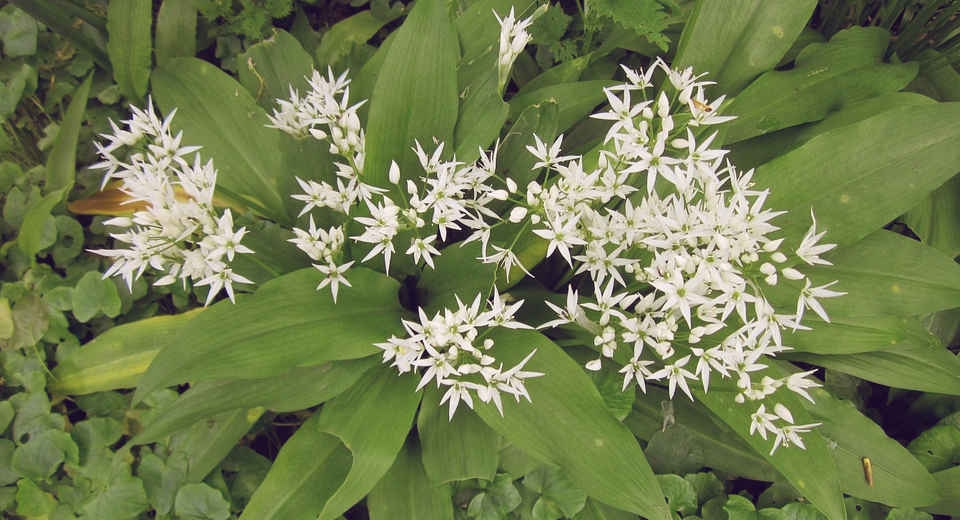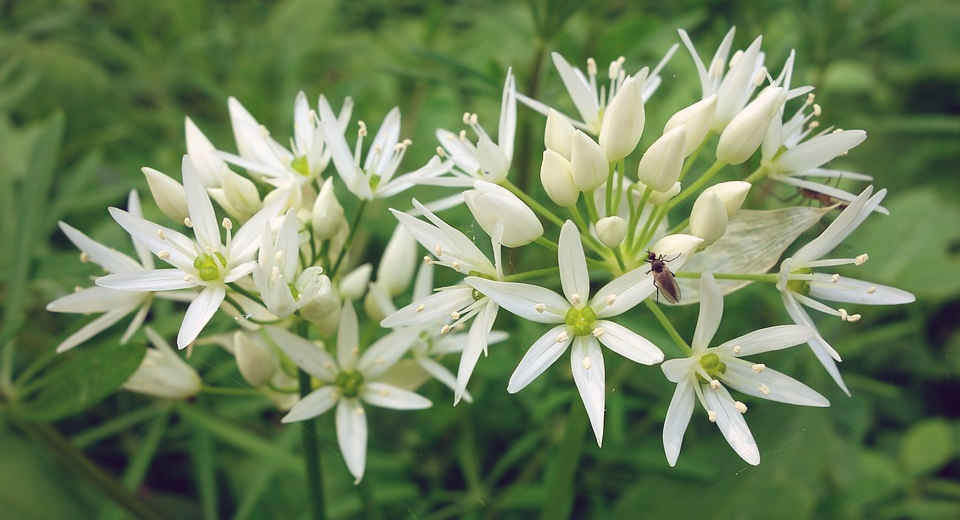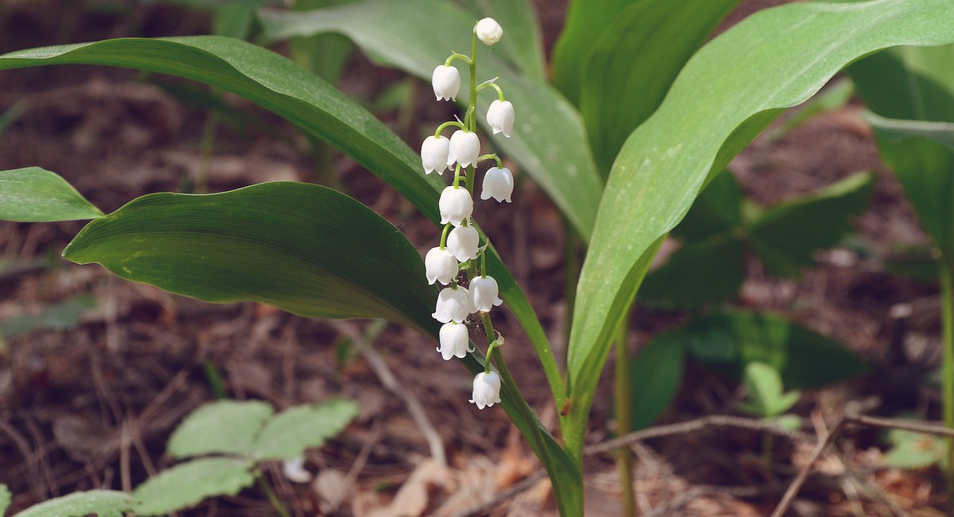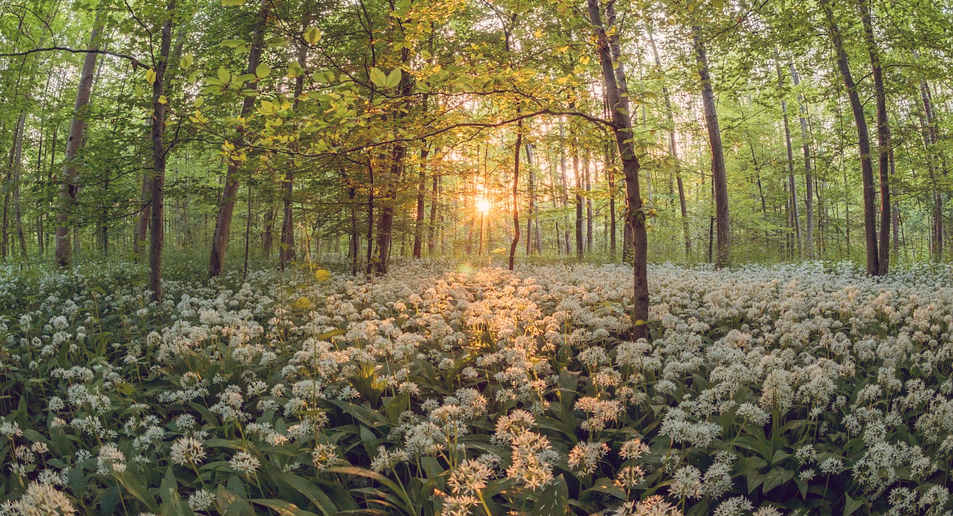Smells spicy, tastes delicious and you don’t have to buy it at the weekly market: anyone can collect wild garlic. However, this is how to collect wild garlic because you should follow a few tips and rules.
Wild garlic is also called spring herb in the vernacular, because it is one of the first plants you can collect in the year. The herb belongs to the allium family and is one of the best-known native wild herbs. Everything you need to know as a collector, you can find out here: When and where to collect wild garlic and most importantly – how to collect it and recognise it and distinguish it from the poisonous lily of the valley.
In recent years, the spicy tasting herb has become fashionable and there are many great recipes for wild garlic soup, wild garlic pesto, wild herb salads and many other dishes. From spring onwards, wild garlic also appears on restaurant menus and at weekly markets – or you can simply go and collect wild garlic yourself, because the medicinal and aromatic herb is widespread in Germany and is not under nature conservation. Only in Brandenburg and Schleswig-Holstein is wild garlic on the red list as an endangered species: you can still harvest it there, but you should always follow the collecting rules listed here!
Tip: There are many more spring activities to discover on Greatime!
How to Collect Wild Garlic – What You Should Know
It not only tastes good but is also very healthy: the spicy herb with its garlicky flavour is also good for your health. Wild garlic contains vitamin C, potassium and calcium, iron and magnesium, improves metabolism and blood circulation and aids digestion. Sometimes the collector only needs to follow his fine nose to go and collect wild garlic. The spring herb smells like garlic, but unlike garlic, it does not cause bad breath or body odour.
What Does Wild Garlic Look Like?

Wild garlic is a herbaceous perennial plant – so if you have already found wild garlic at one location, it is worth collecting wild garlic there again next year. Elongated, pointed leaves grow in dense clusters on a roundish stalk up to 20 mm long with three edges. When collecting wild garlic, harvest the young leaves. They are up to 25 cm long and about 2 – 5 cm wide. The upper side of the leaf is dull dark green, the underside lighter. The elongated leaf veins running to the leaf tip are an important distinguishing feature.

From the end of March at the earliest, stalks with 20 white, star-shaped flowers grow from the centre of the leaf rosette. After flowering, capsule fruits grow from them, each with a seed ball.
How to Distinguish Wild Garlic From Lily of the Valley?

When collecting wild garlic, you should be aware that the medicinal herb can easily be mistaken for the poisonous lily of the valley. What’s more, the poisonous doppelgangers like to grow in the same places. In order to avoid confusion, you should know the important distinguishing features with which you can clearly distinguish wild garlic from the poisonous lily of the valley.
- The clearest distinguishing feature is the scent of the plant: sometimes you can smell wild garlic from far away. To be sure, simply rub a leaf between two fingers and you should immediately detect a distinct garlic scent. Neither the leaves of the lily of the valley nor those of the meadow saffron have this scent. But beware: if you have just rubbed a wild garlic leaf, the scent will still cling to your fingers and can be deceptive the next time you rub it. Therefore, never go by the smell alone!
- Also look closely at the top of the leaf: Bear’s garlic leaves are matt, Lily of the valley leaves are shiny. Unlike meadow saffron, the petiole of wild garlic is thin and grows singly from the ground.
- Bear’s garlic flowers about 2 months earlier (from March) than the lily of the valley (from May). In addition, the two plants differ in flower shape: Lily of the valley bears flowers in the shape of bells, the bear’s garlic flowers are star-shaped.
When Is Wild Garlic Available?
Depending on the temperatures and the area, wild garlic grows from early March to early June. If you want to be sure to find wild garlic, you can start picking at the end of March. The main harvesting time is in March and April, because wild garlic starts to flower in April at the latest.
The young, tender leaves should be harvested, as they taste spicier. The pretty white flowers of wild garlic are also edible and taste nice and spicy. However, when gathering wild garlic, you should avoid harvesting leaves from plants that are already in flower. They no longer taste as fresh as young leaves and become fibrous.
Where and How to collect Wild Garlic?

Bear’s garlic is widespread throughout Germany, although it is more common in southern Germany and the Alpine region than in northern Germany. Only in Brandenburg and Schleswig-Holstein does the early-flowering plant occur rather rarely and is endangered – but you can still collect wild garlic for your own use here. Often a single spot is enough to collect wild garlic, because the herb is very spreading and grows as a dense carpet in wild garlic colonies.
The medicinal herb likes it shady to semi-shady and moist: it grows in alluvial forests, along rivers and creeks but also in parks and gardens. It likes nutrient-rich, calcareous, loose soils that drain water, as it does not tolerate waterlogging well. Wild garlic is also called forest garlic and likes to grow in deciduous forests. I have also found it in the English Garden in Munich.
How to Collect Wild Garlic – Most Important Collecting Rules
When collecting plants, the following applies: try not to damage nature and do not plunder it. Harvest only 1-2 leaves per plant so that it can continue to reproduce.
- Collect wild garlic away from paths – especially roads and dog tracks
- Check all the features before you start harvesting
- Try not to step on the plants
- Collect in large stands of wild garlic
- Harvest only 1-2 leaves from each plant
- Cut off the leaves and do not pull them out
Wild garlic can be eaten raw, but we advise against it because of the risk of fox tapeworm. I prefer to use bought wild garlic and my collected leaves for cooked dishes.
Did you know that you can collect mushrooms in spring? On Greatime you’ll find lots of ideas for activities with kids, your partner and friends.
Never miss a good idea again and just follow us on Facebook and Instagram and subscribe to our newsletter 😉
*There are affiliate links in this article. This means that if you order a product from amazon via one of these links, Greatime will receive a small commission without the product becoming more expensive for you.

![How To Collect Wild Garlic Everything You Need To Know [Uber En="This*is*how*to*collect*wild*garlic*in*Germany*from*March" De="Bärlauch*sammeln*kann*man*ab*März*in*Deutschland"]](https://greatime.de/wp-content/uploads/2019/03/baerlauch-sammeln-1.jpg)
![Uber En Quot Mother 039 S Day Breakfast Quot De Quot Muttertagsfr Hst Ck Quot [Uber En="Mother's*Day*Breakfast*ideas*to*make*any*mother*happy" De="Ideen*für's*Muttertagsfrühstück,*die*jede*Mutter*glücklich*machen"]](https://greatime.de/wp-content/uploads/2019/04/muttertagsfruehstueck-1.jpg)
![Uber En Quot Street Festival Quot De Quot Bergmannstra Enfest Quot [Uber En="Turn*your*street*festival*into*a*rally!" De="Macht*euer*Straßenfest*zu*einer*Rallye!"]](https://greatime.de/wp-content/uploads/2016/07/strassenfest-rallye.jpg)
![Crossboccia [Uber En="The*outdoor*throwing*game*Crossboccia*is*a*new*trend*sport." De="Das*Wurfspiel*Crossboccia*ist*eine*neue*Trendsportart."]](https://greatime.de/wp-content/uploads/2016/07/crossboccia-close.jpg)